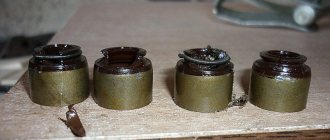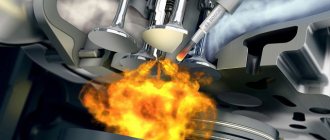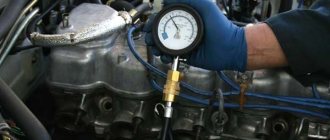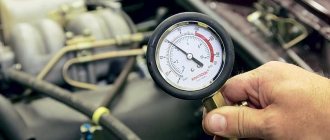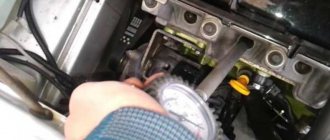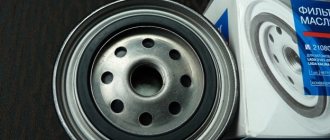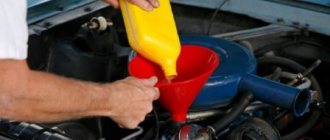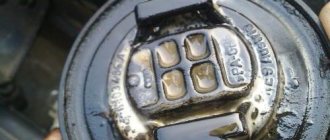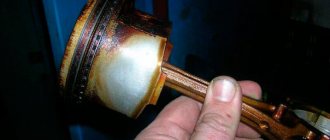When a car has been in use for a long time, the car owner begins to notice a gradual increase in engine problems. Extraneous noise appears, power decreases, and engine starting becomes difficult even when using high-octane fuel.
Domestic cars with an engine capacity of 1300-1500 cm3 are most susceptible to these problems. But often on Russian roads, especially when using low-quality gasoline, even an expensive imported car begins to let its owner down.
Fortunately, in many cases it is quite possible to restore (or maintain for a long time) the original characteristics of a car even for an inexperienced car enthusiast without contacting service centers. The easiest way to do this is to use various automotive additives.
Their range is quite wide, and they can solve various problems with the car. The most common reason for a drop in power is a decrease in engine compression.
Main signs and causes of low compression
The first step is for the car owner to accurately diagnose this defect. Next, you need to determine what exactly led to the compression problems. A number of indirect factors may indicate a drop in cylinder pressure:
- reduction in power even when using high-quality gasoline;
- increased fuel and oil consumption;
- the appearance of thick acrid smoke from the exhaust pipe.
If at least one of the above signs is present, the car owner should check the pressure in the car’s cylinders.
Important! One of the most common causes of lack of compression is loss of tightness in the cylinders due to wear of the piston rings.
If the piston rings wear excessively, oil begins to enter the combustion chamber, which leads to the formation of black smoke during the exhaust. Sometimes engine malfunctions begin to occur after a major overhaul, during which the valves or crankshaft were replaced.
Due to poor installation, the valve no longer fits tightly to the groove hole, the seal in the cylinder is broken and the power drops. The use of low-quality fuel or oils and lubricants can also cause a drop in pressure in the engine. Piston rings can simply “burn out” due to bad gasoline, leading to a decrease in compression.
Increased compression - increased power: the second fairy tale
Not certainly in that way. Compression can be increased in two ways - increasing the compression ratio or reducing leaks from the combustion chamber. Let's see what happens in each case: we have a stand at our disposal.
First, let's reduce the volume of the compression chamber. The easiest way to do this is to grind the bottom plane of the cylinder head. The base engine of the “eleventh” VAZ has a cylinder displacement of slightly more than 370 cubic meters. With a standard compression ratio of 9.8, the volume of the compression chamber will be 42.6 cm³. You can calculate that by removing 2 mm from the seating surface of the cylinder head, we reduce the volume of the compression chamber by 5.1 cm³. The new compression ratio will be 11 units, that is, 1.2 higher than that of the base engine. Now, just out of interest, let's remove another 2 mm. The compression ratio increases to 12.6. In the textbook we find the required formula and get: the thermal efficiency of the piston engine cycle should theoretically increase in the first case by at least 4%, in the second - by 9%. Great!
Now we put these heads on the bench motor and take the torque characteristics. The reduction in fuel consumption is significantly less than the theory promised - by 2.5% in the first case and by 4.5% in the second. Moreover, the effect is more pronounced in the zone of low loads. The increase in power is even less: 2–3% at most, and in the low and medium speed zone. And at high levels there is no effect.
Everything is clear: with an increase in the compression ratio, the pressure in the cylinder increases sharply, this increase provokes detonation, the corresponding sensor catches it and shifts the ignition timing back. Consequently, the power drops. And therefore the theoretical effect is significantly reduced. But the exhaust temperatures increase, which means that the risk of burning valves and pistons with such an engine is much higher.
The second method is to reduce leaks. Let's start from the opposite: let's compare what will happen to the torque characteristic if we replace the rings so that the gaps in them become, say, twice as large.
Done. For a new engine everything is fine, compression is 13.2 for all cylinders. 13.4 bar. For one damaged by rings with large gaps - 10.8. 11.1. What did the power measurements show? In the low speed zone, the power of the damaged motor dropped slightly, but when we reached 2500 rpm, the torque curves almost merged. This is because leaks from the combustion chamber into the crankcase, which should reduce power, are noticeable only at low speeds, and at high speeds their mass per cycle drops sharply, because with a decrease in cycle time and an increase in crankshaft rotation speed, the time for leakage also decreases .
Compression increased sharply, but power did not. Along with compression, detonation arose, and the ignition timing had to be shifted back. And it affects the power more.
Diagnostics using instruments
If there are indirect factors for a drop in pressure in the cylinders, instrument diagnostics should be carried out to confirm the problem and identify the causes that caused it. Any car enthusiast should have at his disposal devices and tools that allow him to carry out at least minimal engine diagnostics. To confirm the pressure drop in the cylinders you will need:
- a device for measuring pressure in the engine (called a compression gauge);
- several keys (including for possible removal of the cylinder block cover);
- syringes.
Every car owner should always have this simple set of tools at hand. The most accurate data is provided by a compression meter. It is more convenient to take measurements together with a partner. Before using it, you need to warm up the engine. After this, all the spark plugs are unscrewed one by one, the fuel supply is shut off (the fuel hose is removed), the tip of the compression gauge is screwed or pressed (it all depends on the model) to the spark plug hole.
Next, the driver begins to turn the starter, and his partner, at a signal, begins to monitor the instrument readings. The starter should be turned until the arrow stops creeping up. After that, the compression meter data is recorded on paper. So you should check all the cylinders.
The recorded readings are compared with standard indicators (each car model has its own, usually in the range of 10-15 Atm.), which makes it possible to determine whether there is a drop in pressure in the cylinders, and in which one(s). Usually in the problem cylinder the pressure is sharply different from the rest. Having established the source of the problem, you can disassemble the cylinder block and check for wear.
The higher the compression, the better: the fourth tale
Often, from apologists for various additives, you hear how the compression jumped after the next treatment of the engine. Growth up to 15 bar, up to 17 bar! But we must keep in mind that in normal condition, even after restoring the gaps to the state of a new engine, you will not get compression higher than standard.
Where do the numbers come from? Usually, on a disassembled engine, it is clear that after processing the combustion chamber is overgrown with something unknown and, as a result, the volume of the compression chamber has decreased. But these deposits interfere with heat removal from the combustion chamber. Hence detonation, glow ignition, etc. So we shouldn’t rejoice at the unprecedented increase in compression, but vice versa.
Change in specific fuel consumption at fixed speeds (2500 rpm) in two engine variants - basic and with rings in which the gaps are increased. Compression has dropped, but in terms of consumption this is noticeable only at low loads.
A simple way to restore engine compression
If the cause of the pressure drop is not a poorly performed repair, but worn piston rings or a large amount of carbon deposits, the use of special additives can help. These substances allow you to restore (to a reasonable extent) worn surfaces of pistons, cylinders, rings, and clean them of carbon deposits.
Advice! In order to increase compression with a small layer of carbon deposits, you can pour a small amount (100 g) of high-quality machine oil through the spark plug hole. After this, you should wait half an hour for the oil to soften the accumulated soot, and start the engine. Usually this measure is enough to restore “normal compression” in the cylinders. The method will be effective only with a small layer of burning.
In the car market, special equipment for improving engine performance is presented in a wide range. There are substances for use in diesel and gasoline cars. The use of additives to restore compression in the engine is quite simple: the driver just needs to pour the additive into the oil of the power unit. Additives added to fuel are also very popular.
And it’s not a fairy tale at all.
So what does compression do? For a lot! The main thing is the starting properties of the motor, especially at low temperatures.
This primarily applies to diesel engines, where the pressure and temperature at the end of compression determine whether the fuel in the cylinder will ignite or not. But gasoline engines in a cold state are also sensitive to changes in compression: it affects the volatility of the fuel, which, during a cold start, should only theoretically evaporate on the way to the cylinder. But in reality, it gets there in the form of non-flammable liquid drops.
Reduced compression increases crankcase gas pressure. In this case, a larger volume of oil vapor flies through the ventilation system to the engine inlet. This is bad: toxicity increases, and the rate of combustion chamber contamination increases sharply.
Uneven compression across the cylinders causes engine vibrations, especially noticeable at idle and at low speeds. And this, in turn, harms both the transmission and the engine suspension. And to the driver himself.
In short, the role of compression as a diagnostic sign, largely characterizing the condition of the engine, is very great. And our “fairy tales” in no way call for giving up on her - on the contrary! But the desire for an unbridled increase in it in search of additional “horses” is generally futile.
Source
Types of additives for increasing engine compression, their advantages and disadvantages
High-quality additives for oils or fuel can reduce wear of components and parts and increase compression. There are quite a lot of types:
- Remetallizants are additives containing ions of soft metals (copper, tin, cadmium). They form a protective thermomechanical coating on the surface of the parts.
- Additives containing Teflon.
- Conditioning additives. They are made from chloroparaffin compounds, which break down substances formed during wear of parts. In addition, these additives contain a high content of fluorinated polyesters, which provide a protective thermomechanical coating for rubbing surfaces.
- Layered friction modifier additives. A layered layer containing molybdenum, tungsten, and graphite is formed on the parts. This layer is characterized by low shear forces, providing a low coefficient of friction to increase the service life of parts.
- Additives-geomodifiers. Contains serpentine, graphite, magnesium, and forsterite compounds. When friction occurs, serpentine begins to decompose, releasing energy that heats and softens the metal. A complex chemical reaction begins, as a result of which a composite ceramic-metal layer with high wear-resistant and strength characteristics is formed on the surfaces
All of these supplements have both positive and negative sides. They are compared in the table:
What is compression?
Compression is the amount of pressure that will be created at the top of the cylinder at the moment of compression.
If compression is absent in the cylinders or is below normal, this indicates that the engine is malfunctioning and will require expensive repairs in the near future. Sometimes, you can get by with a little damage and avoid major repairs, but this usually doesn’t last long, and after some time it will disappear again.
For different engine types, there should be different compression. It differs radically between gasoline and diesel engines.
Pros and cons of different types of additives
| Additive type | pros | Minuses |
| Remetallizants | compression is restored; |
gasoline consumption is reduced;
a protective layer is formed on the parts;
The additive must be re-added at every oil change.
poor durability of the coating;
the protective layer is afraid of high temperatures;
increases the concentration of phosgene in exhaust gases;
Long-term use may cause a layer of carbon deposits to form on the piston rings.
formation of a protective layer on the surfaces of parts.
The paraffin-containing protective coating is resistant to high temperatures.
sulfur compounds enhance the corrosive properties of exhaust gases;
graphite particles settle on the valves, impairing their performance.
reduce oxidation and extend the life of the oil;
significantly reduce friction;
are not afraid of high temperatures.
Of course, any additives will not cancel major repairs. Their effectiveness is not limitless. However, selecting them correctly and starting to use them immediately after purchasing a car will significantly delay expensive repair work and extend the overall service life of the car.
Car enthusiasts, I’m interested in your opinion about additives in the engine, gearbox, steering wheel, and where else they are. How effective is this product? Who used which ones and how they helped him.
I tried the power steering on a Volvo 440, but it didn’t help. I took a “Hado.”
And according to XADO, the power steering is positive. Everything is as in the instructions - after 100 km the noise disappeared, it’s just that your power steering is completely out of whack
The instructions for the new car only say about fuel additives, and even then, I doubt their necessity. Of these things, I only used radiator sealant, and only as a temporary measure until a new one arrived.
The sealant of the cooling system was also leaking (a necessary measure from home 1500 km.) Then I changed the heater radiator, it sealed it so much that it almost cooled down.
How additives work
Compression additives work on a similar principle. First of all, they are catalysts that accelerate crystallization on engine surfaces. When added, a protective film is formed on the rubbing parts, which reduces the load on the power unit. The use of additives helps restore the crystal lattice of metal parts. When disassembling a motor that worked with the addition of an additive, it is clear that all components have a smooth mirror surface. As a rule, additives are used to increase the compression of the internal combustion engine after 60 thousand kilometers. This allows you to save all components from wear. Motorists highlight the following advantages of using the additive:
- aligning and increasing cylinder compression;
- increase in oil pressure;
- elimination of coking.
Another undeniable plus is the delay in major car repairs. There is also a noticeable slight reduction in fuel costs, which has a positive effect on savings over long service life. So, we have become familiar with the principle of operation, now we need to figure out what types of additives there are.
When to use
Let's compare the additive with tablets. You will not use medications unnecessarily, even if everyone around you praises them and convinces them of their incredible effectiveness and excellent healing effect. The same should be done with auto chemical goods; use additives, adding them to an engine with high mileage, only when the need arises. Experienced drivers consider auto chemicals, which are poured into oil for a diesel or gasoline engine, as a lifeline. If you begin to notice that your engine is not in order, you will only have a few options, from which you will have to choose the most suitable one:
- carry out expensive repairs of the internal combustion engine;
- purchase a new internal combustion engine (we note right away that buying a used engine is not recommended, since you can buy a “pig in a poke”; after installation on your car, it may turn out that it is also in poor condition);
- add the additive to the engine oil.
The most affordable option of the three listed is the introduction of a “miracle cure”. In addition, you can get instant results, whereas repairs are not carried out in one day, nor is installing a new engine. A high-quality additive can revive the engine and allow the car owner to continue using the vehicle for some time, during which the motorist will have time to accumulate the required amount for repair work.
The best additives for diesel engines
For cars running on diesel fuel, additives are needed no less than for gasoline vehicles. This is especially true for cars that have been in operation for several years - a large amount of soot has already formed in their exhaust system, and fuel consumption has noticeably increased. Special additives allow you to optimize engine performance, improve fuel parameters and reduce fuel consumption.
LIQUI MOLY Diesel Flies-Fit K
The promise of reducing the pour point of winter fuel to -50 degrees on the can is, of course, good, but let's take a closer look. Since Liqui Moly antigel is a concentrate, the high price per liter is actually not that high: the instructions indicate that one measuring cap (25 ml) should be poured into 25 liters of fuel. Simply put, a liter can, when used according to the instructions, will allow you to “adjust” a thousand liters of fuel, increasing the price of each liter by a ruble and kopecks, which is not so much.
As for the pour point, you need to understand that for anti-gels this is more of a publicity stunt - the most important thing for us is the maximum filterability temperature, because what does it matter to us that the fuel has not yet frozen if the booster pump is no longer capable of pushing it through the filter? But here the technical documentation is much more modest, indicating that “depending on the quality of the diesel fuel, the filterability limit temperature improves by -10 °C.” In practice, we can talk about 6-7 degrees of gain for “average commercial” diesel fuel. Not so much? In fact, this is a good result for an antigel, especially taking into account the fact that the additive reduces the cetane number minimally - and often it is precisely this that antigels hit very sensitively, which, for example, for modern diesel engines with common rail, multi-component catalysts and particulate filters is already extremely undesirable. To protect against cold weather in the off-season on summer diesel fuel, Liqui Moly is enough. In addition, do not forget that the concentrate can be used at lower temperatures (from -25 to -35 degrees) and in a ratio of 1:500: more expensive, but more reliable. The additive quite clearly increases the lubricating properties of the fuel - and this is only beneficial for the high-pressure fuel pump or unit injectors.
Main advantages:
- Overall normal efficiency
- Low impact on cetane number
- Low price per liter of processed fuel
Minuses:
- No critical
Castrol TDA
Suitable for engines that run on diesel fuel. With its help, the corrosion process slows down and the negative impact of fuel components on fuel system parts is reduced. And this product, suitable for any season, will be most effective when used in winter. PROS:
- the ability to optimize the process of starting the power unit at any time of the year - although the effectiveness of the additive increases in winter;
- no effect on fuel viscosity and increase in its lubricating properties;
- reduction of noise and soot formation from a car engine.
Minuses:
- Less effective when using the additive in the warm season;
- As the dosage increases, the risk of rapid contamination of the fuel filter increases. To solve this problem, filter elements have to be changed several times more often.
ASTROhim Antigel
Our rating of the best diesel fuel additives ASTROhim Antigel continues. “Multiple test winner” (as proudly stated both on the packaging and on the manufacturer’s website) is available in a variety of packaging - from 300 ml bottles to 200 liter barrels. The most difficult thing to understand is the compact “passenger” packaging, since there are already three options: the same 300 ml can be designed for 30 liters of fuel (code AC-119), 60 liters (AC-120) and 120 liters (AS-121). As a result, if you are not careful, you can make a mistake, because in these three options the concentration of the concentrate itself (sorry for the tautology) is different.
In general, the composition is quite cheap - taking the same liter jar for comparison with Liqui Moly (devoid of a measuring cup and funnel, unlike the German competitor), we get an increase in the price of a liter of fuel at the specified concentration of approximately 97 kopecks: slightly less than that of Liqui Moly , but not critical. What about the characteristics? Well, the additive significantly reduces the pour point of the fuel, deteriorates the cetane number slightly... but the maximum filterability temperature does not decrease much, that is, we have more of a “defrost” of fuel than a full-fledged antigel, which should also prevent the crystallization of paraffin . As a result, overall, we will probably leave Astrokhim without first place this time.
Main advantages:
- Low price
- Low impact on cetane number
- Improving the lubricating properties of fuel
Minuses:
- Confusion with 300 ml packaging
- Inconvenient dosage
- Not the best reduction in filterability limit temperature
Hi-Gear Diesel Antigel
The American-made product provides improved diesel fuel performance without a noticeable increase in costs. By adding an additive to summer grades of fuel, you can increase their pour point to -27 degrees, and to -51 degrees for winter grades. The effectiveness of the product has been tested and confirmed by specialists from different countries, including Russian automotive experts. PROS:
- effective reduction of fuel filterability level and gelation temperature;
- safety during use - the dispersant additive does not lead to engine failure even under extreme engine operating conditions;
- affordable price compared to products of other brands - depending on the concentration, from 1 to 3 rubles are spent on processing 1 liter of fuel;
- absence of fakes on the market.
Minuses:
- The can's ill-conceived dosing system.
- There is a strong change in properties after the expiration date, so it is recommended to use the product only within the period specified by the manufacturer.
Mechanical damage
The most common cause of mechanical damage is valve problems. They often burn, bend, and fall out. This happens due to the lack of normal mating of parts and gas breakthrough. There are several reasons why a valve can become bent. The most common one is belt rupture. Because of this, the valve meets the piston and is defeated in this unequal battle. Therefore, the belt should be changed on time.
Pistons are just as susceptible to damage as valves. For example, when refueling with low-quality gasoline, detonation occurs. The consequence of such a fuel change is the breakdown of the jumpers between the ring grooves. Piston rings can also break due to detonation. Driving without an air filter wears them out a lot and increases the gaps. If foreign objects get into the combustion chamber, then impacts on the piston are quite possible, which will lead to its deformation and slight destruction.
Additives help provide maximum protection for all components and increase compression in the engine. After we have become familiar with the reasons for the deterioration of engine performance, it is worth knowing the principle of operation of additives.

